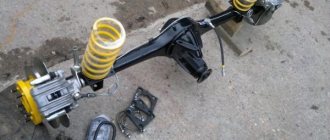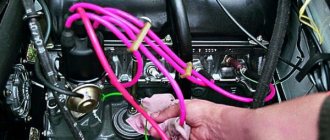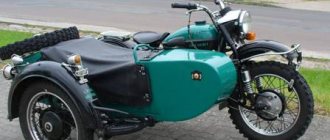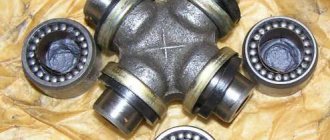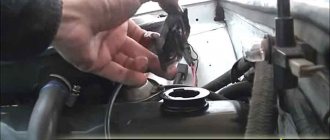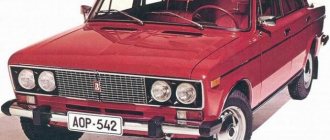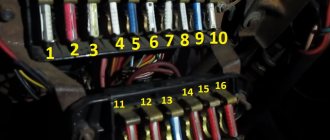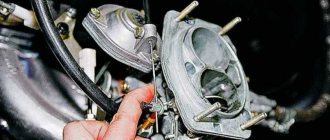Features of the VAZ-2103
“Treshka” was conceived by the manufacturer as a luxury version of ordinary Zhiguli. It owed its appearance to a cooperation agreement between FIAT and the Soviet Ministry of Automotive Industry.
The USSR engineers' ideas about the improved version differed from the opinions of the Italian "techies", and our car turned out to be more attractive than the Fiat 125 series, chosen as a prototype. This is evidenced by the features of the car:
- Excess chrome , screaming about the significant status of the owner, which increased the cost by almost 1.5 times compared to the original “penny”.
- An image of dynamism . The view is more advantageous than the Italian “Speciale” and the VAZ “one”. It was created thanks to the negative slope of the front part, a sharper angle where the wings meet the radiator grille, the combination of the grille with 4 round headlights into a single module, and the unusual rhombic shape of the turn signal. The reflectors and smaller glass made the car appear wider and flatter. The repetition of chrome strips emphasized the dynamism of the silhouette, lengthening it visually and thereby depriving the car of the “turtle soapbox” effect. The thoughtful design of the parts turned the “iron horse” into a moving one, even when the car was stationary.
- Unification of the body with VAZ - 2101 . The middle part and power structure are the same, which experts estimate as 80% standardization. The only difference is in the hinged panels of the bow and stern: on the “kopek” they are almost the same in length, but on the successor the front and rear are different.
- Radial wheels . IYA-179 were a little wider, but noticeably softer than I-151 diagonals.
- Luxurious salon . Pile carpet, a set of 5 round instruments, including an engine oil pressure indicator and a tachometer, a place for an “impressive” radio receiver, a dial clock, a mirror for the passenger from the inside of the sun visor. Even the metal parts at the top of the doors were “dressed” in special linings, due to which it was impossible to see the color of the body from the inside.
- Noise insulation . An additional muffler, better noise protection, the engine’s operation could only be guessed by the tachograph needle.
- Price . The car cost 36% more than its predecessor.
What distinguishes the VAZ-2103 from the VAZ-2106?
What makes these cars different is the size of their engines and, as a very obvious consequence, completely different speeds. By the way, even though it is higher in the sixth model, the “three” is still better in terms of overclocking. Their external differences are noticeable in the design of the rear lights, headlights, and also the radiator grille, which in the VAZ-2106 is made of ordinary plastic. In addition, the “troika” does not have an alarm button, but in the “six” this deficiency has been eliminated.
Which engine is better VAZ 2103 or VAZ 2106
Cars VAZ-2103 and 2106 , popularly called troika and six, have many similarities, because of which many people cannot find the differences between the 2 models. Indeed, both cars are similar from the outside, and the differences in terms of body features are small. But true car owners can simply cite many signs of the difference between the three and the six, and in this article you, dear readers, will also see the differences.
This car was produced at the Volzhsky Automobile Plant for twelve years, from 1972 to 1984. VAZ was developing it together with the Italian company Fiat, and the troika was developed precisely on the basis of one of the models of the Italian manufacturer. In the seventies, the VAZ-2103 created a real sensation among Russian motorists; the car could accelerate to 100 km/h in seventeen seconds. It was boldly associated with European cars, and among Russian models, the troika was the most lively car. Over 12 years, about 1P300P000 models were produced, the main difference of which was the highest comfort and reliability. Then the VAZ-2103 was replaced by the more modern model VAZ-2106.
General characteristics of the VAZ-2103
The VAZ-2103 car began to be produced back in 1972 at the Volzhsky Automobile Plant. Both domestic and foreign designers participated in the development of this car. This model was developed on the basis of the Italian company Fiat. For this reason, outwardly our “troika” is very similar to its Italian counterpart. In Soviet times, this car brand created a real sensation. What made the car popular was not only its beautiful appearance at that time, but also its rather powerful technical qualities. This car could reach speeds of up to 100 km per hour in 17 seconds.
The VAZ-2103 became so popular in Soviet times that the number of models produced reached 1,300,000. The Troika was very popular, but in 1984, manufacturers decided to launch a more advanced VAZ-2106 model into development. To be honest, there were few differences in these two models.
What is the VAZ-2103?
This car began to be produced at the famous Volzhsky Automobile Plant twelve years ago. Initial production of these machines was launched between 1972 and 1984 to be exact. The development of this car was carried out not only by domestic designers. This process was also carried out by specialists from the Italian company Fiat. In view of this, there is nothing strange in the fact that externally, our VAZ-2103 is almost identical to its Italian original. In the seventies, this car model managed to create a real sensation among the vast majority of Soviet motorists. What made it so popular was not only its once attractive appearance, but also its powerful “internals,” thanks to which this car could develop speeds that were simply incredible at that time, about 100 km/h in just seventeen seconds.
What engines were the VAZ 2106 produced with?
VAZ 2106 is a logical continuation of the entire range of automotive products of the Volzhsky Automobile Plant. Including the legendary “six” (not to be confused with the “kopek”), this is an improved version of the VAZ2103. The sixth model was produced in different versions from 1976 to 2006.
At different periods, the “six” was modernized to give the car speed, maneuverability and power, and power units were improved. During all periods of improvement, the car was equipped with a four-stroke in-line carburetor engine.
- 21011 – 1.3 MT equipment, engine volume. 1.3, power 64 hp.
- 2103 – 1.5 MT equipment, engine volume. 1.3, power 72 hp.
- 2106 – 1.6 MT equipment, engine volume. 1.6 power 80 hp
The engine of the sixth model has the same technical characteristics as its predecessor models. The camshaft is located in the upper part of the device; the rubbing mechanisms can be lubricated under pressure and by splashing. All modifications of carburetors since 1990 have a displacement of 1.6 liters and a power of 75 hp. The device is large, its width is 18.5 cm, height 21.5 cm. The assembled weight is 2.79 kg (fuel is not taken into account). Today the VAZ 2106 has a 16 valve engine, the weight of which is 121 kg.
Which engine is suitable for the VAZ 2106
From a theoretical point of view, any engine is suitable for the six, the main thing is that it fits under the hood. But here’s the rub: few cars have small devices. But this can be solved by redoing the bracket. You will also need to re-register the car with the traffic police. And this is not problematic. Therefore, a Lada car owner can make a powerful beast out of an iron horse.
What is the difference between the VAZ 2103 engine and the 2106?
Many people confuse VAZ-2106 and VAZ-2103. Despite the external similarities, there are quite a few differences between 2103 and 2106. So, what is the difference between the two legendary Sovdepov cars:
- Engine volumes. The first model has a displacement of 1.6 liters and 80 hp, and the second one has 1.5 liters and 72 hp.
- Bumpers. The six has rubber or plastic inserts, the three has fang-shaped inserts (like on the 2101).
- Radiator grilles. The three has a grille made of chromed metal. The newer model has a plastic grille located between the headlights. The third model had a grille covering the entire front part of the car.
- Side turn signals. On the sixth modification, the side indicators are rectangular, on the three they are in the shape of a diamond.
- Headlights. The six has two smaller headlights than the three, and the car has headrests.
- Car badges The VAZ-2106 has a rectangular badge, and the VAZ-2103 has a rounded badge.
There is one more feature that distinguishes cars. The troika does not have an emergency stop, which is extremely inconvenient for car owners. And the six has such a button.
Which cars are the most suitable engines for the VAZ 2106?
As mentioned above, you can install almost any motor. But speaking definitely, the engine from Samara or Niva is ideal. Also suitable for Kalina or Priora. Car experts also recommend installing 2112. You can install the engines of the above cars if you do not plan to formalize a change in the design of the car. If you want to formalize the change, then you can easily install a mechanism from Fiat, BMW, Ford, Lancia, Saab, Nissan, Mitsubishi. If we talk specifically about ideal models, these are Lancia Thema 834, Fiat Croma, Alfa Romeo 154. The listed engines are compatible with VAZ, are quite powerful, repairable, and last a long time. Also BM 746, 326 or 536. But the most ideal new thing for a swallow is from a FIAT 124 car. It is ideally compatible with classic Lada cars.
Characteristics of the VAZ 2103 engine
The technical characteristics of the 2103 engine reflect its position in the AvtoVAZ engine line. It was installed on the VAZ 2103, 21023, 21043, 21053, 21061, 2107 models. This is an in-line four-cylinder carburetor internal combustion engine with two valves per cylinder, which runs on AI-92 gasoline. To operate the engine, oil from 5W-30 to 15W-40 is used, with a consumption of 700 g per 1000 km.
Main characteristics of the VAZ 2103 engine
| Name. | Index. |
| Length. | 565 mm. |
| Width. | 541 mm. |
| Height. | 665 mm. |
| Cylinder diameter. | 76 mm. |
| Piston stroke. | 80 mm. |
| Compression ratio. | 8,5. |
| Engine weight. | 121 kg. |
| Compression of the VAZ 2103 engine. | 1 MPa (10 bar). |
| Maximum power at a crankshaft speed of 5600 rpm. | 71 horsepower. |
| Maximum torque at 3400 rpm. | 104 Nm. |
| Fuel consumption when driving on the highway. | 6.9 l per 100 km. |
| Fuel consumption in the urban cycle. | 9.4 l per 100 km. |
| Fuel consumption in the combined cycle. | 8.9 l per 100 km. |
During the life cycle of the VAZ 2103, the engine was repeatedly refined and improved. An injection version of the engine, a version with a contactless ignition system and a host of others were created. These modifications have improved technical characteristics.
The service life of the VAZ 2103 engine, declared by the manufacturer, is 125 thousand km. In practice, the resource is often double the declared one.
Improving the car's engine and transmission
The VAZ 2106 is equipped with a 1.6-liter main engine with a capacity of 82 horsepower, as well as 1.3 and 1.5-liter engines with a capacity of 64 and 73 horsepower. Owners first of all tune the engine in order to increase its power, so that the car is faster and can accelerate even faster. Such work is carried out either by completely replacing the engine or by upgrading the factory one. The engine is disassembled, its cylinders are bored, thereby increasing the volume of the combustion chamber. The crankshaft, pistons and connecting rods are installed from a VAZ Samara family vehicle, preferably model 2109 or 21099, with an engine capacity of 1.5 liters.
To radically change the characteristics of the legendary “six,” it is best to use original VAZ tuning spare parts, which can be found in any auto store. Read what carbon fiber is and how to stick it on a car here.
Since the engine is carburetor, it is either changed to an injection engine or improved. When converting to an injection engine, an electric fuel pump is installed in the gas tank, fuel injectors and a fuel rail are installed in the intake manifold. An air filter for injectors is installed with a receiver and a throttle valve driven by the accelerator pedal. Then an electronic control unit is installed under the hood, which controls all vehicle systems. It is much easier and cheaper to install Euro-3 equipment, since it does not require the presence of catalysts, their sensors and electronic throttle control.
Tuning a carburetor engine involves installing a two-chamber Solex carburetor instead of the factory carburetor. Adjusting its float chamber, increasing the diameter of the fuel nozzles and spray tubes of the economizer and econostat, as well as the throttle valves significantly increases the car's power. Also, the increase in power is facilitated by the installation of a direct flow instead of the standard exhaust system and muffler, due to which the exhaust gases will be completely released, which will prevent the engine from losing power, ensuring that the combustion chamber is filled with a complete combustible mixture without any admixture of exhaust gases. However, it is important not to forget that such tuning of the 2106 increases fuel consumption.
Also, the factory four-speed gearbox can be replaced with a five-speed one from a VAZ 2107, which is ideal for the VAZ 2106 engine. Only this applies to tuning, in which factory engines are improved, and not replacing the engine completely, for which this gearbox will not be suitable. Therefore, with a new engine, a gearbox is selected for it, or a gearbox that comes with the engine from the manufacturer is installed.
Engine 2103 or 2106
I’ll tell you the differences between the VAZ 2103 and 2106 because many people don’t even see them, but would like to know. And so I will begin.
1. The first difference is the engines. The 3 had 1.5L, and the 6 1.6L. Many people claim that the 3 engine is much better. They also say that the six engine loses power during operation and becomes approximately triple in power, they also say that the third engine runs softer, the 06 heats up a little more. I don’t know if you can believe this... You judge 2. Bumpers. On 2103 they installed fangs like those on 2101. On 2106 they installed a bumper with rubber and plastic inserts. 3. The three had a chrome grille, the six had a plastic grille. 4. Glasses on the headlights of the six. 5. The turns on the wings of the 03 are diamond-shaped and the 06 are rectangular 6. The troika has no headrests 7. The troika does not have emergency lights 8. Rear lights
I think the threesome are very cute. In those years, it surpassed even the six and the Niva in popularity. And they say that a three-wheel engine is better than a six-wheel engine. Hardier, faster, more reliable. I don’t know if I can believe this or not...
To summarize:
1. The 2103 has an iron grille, the 2106 has a plastic grille. 2. The 2103 has a grille that goes from edge to edge, and the 2106 only has one between the headlights. 3. The headlights of 2106 are in a special box 4. The distance between pairs of headlights of 2106 is greater 5. The six has a bumper without fangs 6. The 2103 has turn signals in the form of a beveled parallelogram 7. The lights of 2103 are primitive 8. The 2103 did not have an alarm button (some they say that it was still there, but on export versions). 9. The VAZ 2106 has a rectangular nameplate, 10. The three has a 1.5 engine, 72 hp, the six has a 1.6, 80 hp.
For the rear-wheel drive sedan VAZ-2103 (LADA 1500) or simply “troika”, the domestic manufacturer initially provided a new engine 2103 with a displacement of 1.5 liters, built on the basis of 2101. This model also used proven engines from a “kopeck” to 1 .2 liters and from VAZ-21011 by 1.3 liters. VAZ 2106 engines were produced in small quantities for the third Zhiguli model.
Engine VAZ 2103
The 1.5-liter four-cylinder in-line carburetor power unit of the VAZ 2103 received an overhead camshaft, a timing chain drive and a high engine block, which allows the installation of a crankshaft with an extended piston stroke.
Soviet luxury
VAZ-2102 is the last VAZ to have an overseas twin. The rapidly growing brand was faced with the task of launching a new model. What was needed was a luxury version with its own exterior, interior and a more powerful engine. By analogy with the Fiat 125, a luxury model shown the next year after the 124th.
VAZ-2103 (1972–1984). You can see from the front apron whether the car is early or not. In the first copies it was deaf, for which the cars were called “wood grouse”. Then a “grater” appeared - 25 slits were made on the apron for cooling. And only then they made two large slits, as in the photo.
VAZ-2103 (1972–1984). You can see from the front apron whether the car is early or not. In the first copies it was deaf, for which the cars were called “wood grouse”. Then a “grater” appeared - 25 slits were made on the apron for cooling. And only then they made two large slits, as in the photo.
This time the VAZ team did not take something ready-made, because the Fiat 124 and Fiat 125 were essentially different cars. And the new VAZ needed to be unified with its predecessor. And in Togliatti they did a brilliant job, creating one of the most beautiful cars in our automotive history - the VAZ-2103.
The interior of the three-ruble note is incredibly beautiful. There were many color combinations, the bare metal on the doors was covered with plastic, and carpet appeared on the floor instead of rubber covering. The center of the front panel was decorated with a clock. And for the first time, a real center console for the A-271 radio appeared. Then this receiver migrated to the 24th Volga.
The interior of the three-ruble note is incredibly beautiful. There were many color combinations, the bare metal on the doors was covered with plastic, and carpet appeared on the floor instead of rubber covering. The center of the front panel was decorated with a clock. And for the first time, a real center console for the A-271 radio appeared. Then this receiver migrated to the 24th Volga.
“Treshka” is beautiful in its details. A row of instruments in individual wells, each key is framed by a chrome frame. And all this on a wooden panel - a real sport chic! No other passenger car of ours could boast of a tachometer at that time!
“Treshka” is beautiful in its details. A row of instruments in individual wells, each key is framed by a chrome frame. And all this on a wooden panel - a real sport chic! No other passenger car of ours could boast of a tachometer at that time!
The VAZ-2103 engine became the main one in the Zhiguli line for a long time and remained so almost until his retirement. 72 hp were removed from one and a half liters. “Treshka” at that time was the most dynamic serial Soviet model.
The VAZ-2103 engine became the main one in the Zhiguli line for a long time and remained so almost until his retirement. 72 hp were removed from one and a half liters. “Treshka” at that time was the most dynamic serial Soviet model.
“Treshka” received four headlights framed by a chrome grille, stylish lights, moldings on the sidewalls and arches, ventilation grilles on the rear pillars, and other wheels. And a completely new interior: seats with fabric inserts, a rear sofa with an armrest, door panels covered with bare metal. The new front panel with “sports” instruments was finished in a wood look, and carpet was laid on the floor instead of a rubber covering. A new engine was installed under the hood - it increased 300 cc, and the power increased to 72 hp.
The front seats were also original compared to the first model. Combined upholstery - leatherette and fabric. Such headrests from the category of “consumer goods” were installed independently.
The front seats were also original compared to the first model. Combined upholstery - leatherette and fabric. Such headrests from the category of “consumer goods” were installed independently.
The rear sofa also received combined upholstery and a central armrest.
The rear sofa also received combined upholstery and a central armrest.
The new Zhiguli not only looked more prestigious than the base model, but also moved better. I change from a “kopeck” to a “three ruble” and clearly feel an increase in strength. The one and a half liter engine has good elasticity and pulls well. And the new interior and additional sound insulation made the “three ruble” noticeably quieter.
Although some stylistic moves have something in common with the Fiat 125 and 124 Special, the exterior of the VAZ-2103 is absolutely independent. And the image turned out better than its Italian counterparts. It's not just us who think so.
Although some stylistic moves have something in common with the Fiat 125 and 124 Special, the exterior of the VAZ-2103 is absolutely independent. And the image turned out better than its Italian counterparts. It's not just us who think so.
I drove all the domestic cars of those years, so I have no doubt: in terms of noise insulation, the “treshka” was almost not behind the much more prestigious and inaccessible 24th Volga. And the stylish interior, made of soft plastic, does not rattle even after 45 years. The VAZ-2103 became a symbol of the success of the Soviet people; it was not for nothing that the well-to-do Ippolit from the film “The Irony of Fate” and the plant director Katerina from the film “Moscow Doesn’t Believe in Tears” drove it!
VAZ-2106 (1976–2006). The “Six” has become a real long-liver. Over the years, the body decor has been simplified - the trim on the arches and chrome moldings on the sills have been abandoned. The wheel caps disappeared.
VAZ-2106 (1976–2006). The “Six” has become a real long-liver. Over the years, the body decor has been simplified - the trim on the arches and chrome moldings on the sills have been abandoned. The wheel caps disappeared.
One of the main changes in the cabin is the seats. They not only changed the upholstery, but also got headrests.
One of the main changes in the cabin is the seats. They not only changed the upholstery, but also got headrests.
Like the “treshka”, the rear sofa of the sixth model received a folding central armrest.
Like the “treshka”, the rear sofa of the sixth model received a folding central armrest.
VAZ-2103 consolidated the success of the young Volzhsky plant. New model every year!
What is the difference between VAZ 2103 and VAZ 2106
The VAZ-2103 and 2106 cars, popularly called “troika” and “six”, have many similarities, which is why many people cannot find the difference between the two models. Indeed, both cars are similar in appearance, and the differences in terms of body features are minimal. But real car enthusiasts can easily cite many differences between the “three” and the “six”, and in this article you, dear readers, will also see the differences.
VAZ-2103
This car was produced at the Volzhsky Automobile Plant for twelve years, from 1972 to 1984. VAZ was developing it together with the Italian one, and it was developed precisely on the basis of one of the models of the Italian manufacturer. In the seventies, the VAZ-2103 created a real sensation among Soviet motorists - the car could accelerate to 100 km/h in seventeen seconds. It was boldly compared with European cars, and among the Soviet models, the Troika was the most dynamic car. Over 12 years, about 1,300,000 models were produced, the main difference of which is high comfort and reliability. Then the VAZ-2103 was replaced by a more modern model - the VAZ-2106. VAZ-2103
VAZ-2106
This model was intended to replace the VAZ-2103, although it cannot be said that the changes in the body and technical characteristics of the cars were very serious. The “Six” also enjoyed great success among Russian motorists, and only in 2006 did it become necessary to discontinue the model. Depending on the series, the cars were equipped with a four- and five-speed manual transmission. The rear-wheel drive VAZ-2106 car could reach speeds of up to 150 km/h, while maintaining increased comfort for the driver and passengers. The model was mostly bought by poor people (middle class) due to its low cost. VAZ-2106
Comparison of VAZ-2103 and VAZ-2106
It cannot be said that the VAZ-2106 model that replaced the VAZ-2103 was completely different. Not at all. The changes turned out to be minimal, although there are quite a few signs of difference. So, what is the difference between the VAZ-2103 and VAZ-2106: The standard VAZ-2103 model had an engine capacity of 1.5 liters, while the VAZ-2106 had an engine capacity of 1.6. Therefore, the maximum speed of the “six” was slightly higher, but the acceleration of the “three” was slightly better. As for the differences in the body, the headlights and radiator grille will catch your eye. The design of the headlights of the VAZ-2106 has undergone minor changes: it has become more strict, plus the distance between the two headlights of one pair has become slightly larger. But the radiator grille of the “six” (later models) was made of plastic, while the VAZ-2103 had a metal grille. The taillights of the VAZ-2103 had a very simple and uncomplicated design, and in the middle you could see a small dividing strip. But the design of the rear lights of the VAZ-2106 has become improved, and the dividing strip was no longer visible.
The VAZ-2103 did not have an alarm button. It could be installed separately. But it was already present on the VAZ-2106.
Features of the VAZ-2106
With the “sixth” model of the Zhiguli, the manufacturers hoped to surpass the “troika”, beloved by car enthusiasts, in comfort and dynamism.
The new car industry was distinguished by the following characteristic features:
- Plastic parts in finishing . They came into fashion and were used in significant quantities.
- The angularity of the contour , which appeared in the transport trend.
- Completely domestic front optics , which Togliatti managed to provide only in 1976. Previously, high accuracy of geometric dimensions was not possible for our manufacturers, which forced them to purchase Italian or Czech headlights.
- Interior changes . Velor seat upholstery. The appearance of head restraints, a brake fluid shortage indicator, smoothly adjustable backlight brightness, and an alarm system. Replacing the foot-operated windshield washer with a manual steering wheel-mounted one.
- Engine . The cylinder diameter increased by 3 mm and became 79 mm, which made it possible to increase the working volume to 1.57 liters. Torque increased by 12%, so the engine began to “pull” better at low speeds. Reducing the gear ratios of the main pair and some gears led to an increase in speed.
- Quiet and smooth . After the end of production of the three-ruble car, its daughter became the quietest and smoothest in the Zhigulevskaya line. The molded plastic parts of subsequent “fives” and “sevens” made noticeably more noise.
- Cost reduction . This happened due to the reduction in cost and simplification of difficult-to-manufacture components, for example, the replacement of the radiator grille covering the headlights with in-depth “pockets” and the rounded ends of the bumpers with L-shaped plastic “tails”. But the leadership in equipment and image affected the buyer’s pocket: the prestigious car was 100 rubles more expensive than the Niva.
Technical characteristics of VAZ-2103/VAZ-2106:
| 2103, 21033, 21035 | 2106, 21061, 21063 | |
| Years of manufacture | 1972 – 1983, 1977 – 1983, 1972 – 1983 | 1976-2001, 1976-2006, 1976 -1993 |
| Dimensions (L x W x H), mm | 4116 x 1611 x 1440 | 4166 x 1611 x 1440 |
| Wheelbase, mm | 2424 | 2424 |
| Body type | 4-door sedan | 4-door sedan |
| Number and arrangement of cylinders | R4 | R4 |
| Engine capacity, l | 1.5, 1.295, 1.2 | 1.600, 1.452, 1.300 |
| Curb weight, k | ND, 965 | ND |
| Total weight, kg | ND, 1430 | ND, 1035, 1045 |
| checkpoint | Fur. | Fur. 4 and 5 speed |
| Engine power, l. With. , at rpm | 72/5600, 69/5600, 64/5600 | 75/5400, 72/5600, 64/5600 (75/5400) |
| Maximum torque, Nm | ND | ND |
| type of drive | 4x2, rear | 4x2, rear |
| Steering type | Worm gear | Worm gear |
| Supply system | two-barrel carburetor | two-barrel carburetor |
| Brake system | drum front and back | drum front and back |
| Front suspension | Double wishbone | Double wishbone |
| Rear suspension | Helical spring | Helical spring |
| Clutch | — | — |
| Acceleration dynamics 0-100 km/h, s | ND, 143 | ND, 150, 152 |
| Maximum speed, km | ND, ND, 21 | ND, ND, 17.5 |
| Fuel consumption per 100 km, l | 8.3 (AI-92) | 7.7/10.5/10.7 (AI-92) |
VAZ-2103 and VAZ 2106, which are much more often called simply “troika” and “six”, have quite a lot of similarities. It is probably because of them that ordinary consumers are wondering: are there any aspects that distinguish the two models of these cars? Let's say right away that such differences exist. But, to a greater extent, they come down to the “insides” of these cars and only minimally extend to their appearance and, in particular, to the body.
What is the difference?
| VAZ-2103 | VAZ-2106 | |
| Working volume, cubic meters m | 1451 | 1570 |
| Acceleration of the 1st hundred m, s | 19, i.e. a bit better | 18 |
| Max speed, km/h | 150 | 154 |
| Power, hp | 75 | 80 |
| Weight, kg | 1030 | |
| Lattice | Metal from edge to edge | Only between the headlights and later became plastic |
| Headlights | The distance within each pair is smaller | In a special recess |
| Bumper | With "fangs" | ‑ |
| Turn signals | Usually diamond shaped | Rectangular |
| Lanterns | More primitive, only 2 colors | More difficult |
| Nameplate | Rounded top and bottom lines | Rectangular |
| Cost, rub. | 7500 | 9100 |
Which Engine is Better VAZ 2103 Or 2106
Which engine is preferably VAC 2103 or VAC 2106
Auto VAZ-2103 and 2106 , ordinary people called three and six, have a lot in common, so many people cannot find the differences between the two models. Indeed, both cars are similar in appearance, and the differences in body features are small. But real car owners may just notice the difference between three and six, and in this article you will see the differences too, dear readers.
This car was produced at the Volzhsky Automobile Plant for twelve years, from 1972 to 1984. VAZ jointly developed it with the Italian company Fiat, and all three were developed based on one of the models of the Italian manufacturer. In the seventies, the VAZ-2103 created a real sensation among Russian motorists; the car could accelerate to 100 km/h in seventeen seconds. It is boldly associated with European cars, and among the Russian models, the top three turned out to be the most loaded cars. About 12P300P000 models were produced in 12 years, the main difference. highest comfort and reliability. Then the VAZ-2103 was replaced by the more modern model VAZ-2106.
READ Oil change in Haldex Volvo XC90
This model was intended to replace the VAZ-2103, although it cannot be said that the body configuration and technical characteristics of the cars were very strict. The Six was also a huge success among Russian motorists, and it was only in trouble that a model appeared to be discontinued. Depending on the series, the cars were equipped with four- and five-speed manual transmissions.
VAZ 2106 ICE 2103
Our contact group:
VAZ 2103 vs VAZ 2106 Who is faster than VAZ 2103 or VAZ 2106
VAZ 2103
against
VAZ 2106
.
Who is faster VAZ 2103
or
VAZ 2106
?? Let's find out now.
The rear-wheel drive VAZ-2106 could reach speeds of up to 150 km/h, maintaining increased comfort for the driver and passengers. The model was bought mainly by poor people (middle class) due to its low cost. It cannot be said that the VAZ-2106 model, which replaced the VAZ-2103, was completely different.
My pleasure. The changes have been minimal, although there are quite a few differences. So what is the difference between the VAZ-2103 and VAZ-2106: the standard VAZ-2103 had a 1.5-liter engine, and the VAZ-2106. 1.6. So the top speed of the six was slightly higher, but the acceleration of the three was marginally better . As for the differences in the body, the headlights and radiator grille catch the eye.
READ Replacing Engine Mounts Niva Chevrolet Video
The design of the VAZ-2106 headlights has undergone minor changes: it has become more rigid, plus the distance between the two headlights of one pair has become slightly larger. But six radiator grilles (later models) were made of plastic, while the VAZ- 2103 had a metal grille. The taillights of the VAZ-2103 were very simple and simple, and in the middle you could see a small dividing strip. But the design of the rear lights of the VAZ-2106 was improved, and the dividing strip was not visible. The VAZ-2103 did not have an alarm button. Can be installed separately.
But he was already present on the VAZ-2106. Difference. Ru determined that the difference between the VAZ 2103 and the VAZ- 2106 works as follows: the engine size is different. As a result, different speeds (higher for the sixth model) and acceleration (for three) better acceleration).
Salon
Modernizing the interior of a VAZ 2106 involves changing the dashboard (or modifying the existing one), redoing the interior trim and installing new seats for more comfortable ones. For this purpose, seats from Ford, Audi, BMW and other foreign cars are used.
LED lighting is installed on the car dashboard, technical equipment is changed and improved: an on-board computer, a navigator, and a full-fledged multimedia system are installed (this is often a tablet computer with Internet access and connected to the car’s audio system).
The design of the seats and interior trim must be identical, otherwise the design of the interior of the car will be inharmonious.
Characteristic features of Soviet cars
Soviet cars have densely filled the car market, and to this day they are among the most convenient and easy to maintain. Like every car, the VAZ has its pros and cons. Each driver evaluates his financial capabilities, needs and wishes when purchasing a car and is guided solely by personal needs. If the choice nevertheless falls on the “six” or another car of this kind, then it is worth keeping in mind its characteristic features. Lada cars are not particularly resistant to corrosion, but the VAZ-2106 has higher resistance than all its “brothers”.
The interior of the Zhiguli is quite spacious and comfortable. It can comfortably seat five people, including the driver. The advantage of the Shokha is the large glove box, but the front panel is rather its disadvantage. It's not very comfortable and you can't put anything on it.
Another weak point of the Lada is its electrics. However, even at this moment, the VAZ-2106 has advantages over the “kopek” or “seven”.
Lada cars do not need frequent overhauls of the transmission and chassis, but minor problems can happen often. Since the current quality of components leaves much to be desired, the main parts that most often need replacement or repair are:
- Spherical bearing.
- Shock absorption system.
- Brake pads.
When the car's mileage reaches more than 100 km, problems with the suspension, bearings and driveshaft may occur. The gearbox also deserves special attention. If the car’s mileage is already high, then most likely it’s time to change something in the box.
The most important advantage in the Soviet automobile industry is its prevalence and accessibility. Even if the car owner, due to his inexperience, cannot cope with this or that problem, then there will definitely be comrades who can advise and help in this matter. Also, if there is a need to purchase new parts, their cost will not be too high. Finding parts for any VAZ car model will not be difficult.
Distinctive features of the VAZ-2106
This model was discontinued relatively recently, just eight years ago. Despite the fact that the changes in it were not so significant, the “six” was in even greater demand among domestic motorists. There were several series of this car. Depending on them, the VAZ-2106 could be equipped with a four- or five-speed manual transmission.
If we are talking about the rear-wheel drive VAZ-2106, then it should be noted that it could reach speeds of up to 150 km/h . At the same time, at least according to the manufacturer, increased comfort for the driver, as well as each of his passengers, was maintained. By the way, these two models were intended for poor people, for the middle class, as it is now commonly called.
External tuning.
External tuning of a VAZ is carried out if you want to change the appearance of your six. Before starting work, check the condition of the car body.
If there are traces of rust or dents, remove them first. Otherwise, a little time will pass and your tuned car will have to be redone.
Headlights.
Their appearance and quality leave much to be desired. Installing halogen or xenon lamps will significantly improve lighting. When replacing lamps, do not forget about the standards. It's better to choose a good manufacturer.
Body kit
These include bumpers, rear and front, side skirts. Tuning with body kits is the most inexpensive way to change the appearance of a car.
Wheel disks
One of the elements of external tuning is replacing classic wheels with cast ones. Such discs look more aesthetically pleasing.
Forged wheels SLIK for VAZ 2106
In addition to beauty, replacing disks is utilitarian in nature:
•alloy wheels are lighter, which means the load on the suspension will be reduced;
•alloy wheels are cooled better. Some alloy wheel models have additional ventilation holes, which provide additional cooling to the brakes.
Selecting disks
How to choose wheels for a car? Knowing the factory parameters of the car's wheels, this is not at all difficult to do. By increasing the diameter of the disk, while reducing the rubber profile, we will maintain the overall diameter of the wheel; then we need to look at the width of the disk. If you have chosen a size that is significantly larger than the factory one - remember, it will probably also be wider, the question arises whether these wheels will fit into the original arches. If, for example, the offset is large, then you can hitch the wheel on the arch. Of course, you need to take into account drilling (the diameter of the centers of the mounting holes).
The diameter of the disc can be increased by reducing the rubber profile. Here we will get a significant advantage to handling, since the car will be less shaky in corners. Before you buy new disks in a store with the planned diameter, remember that the width of the disk and its offset are also very important technical characteristics of the disk.
VAZ 2106 on fire
If these parameters are not selected correctly, it may happen that the wheel sticks out beyond the arch and “scrapes” against it on uneven roads. Agree, this is not a very pleasant phenomenon. Plus, dirt from the wheels will be widely scattered throughout the car. You will have to wash it more often.
In addition to cast wheels, there are also forged or light alloy wheels. These wheels are called forged because they are produced using the die forging method. In terms of strength and ductility, forged wheels are superior to cast wheels. And their weight is 30% less. True, their price is much higher than cast and stamped steel wheels.
Which model should I buy?
Before the models were discontinued (“three rubles” in 1985, “sixes” in 2005), they were considered “luxury”. But the earlier car was more popular, so connoisseurs of retro cars should choose the VAZ-2103 if they:
- They love prestige and quietness;
- Speed-emphasizing design is appreciated.
2106 is preferable to buy for those who want to own a copy of the domestic classic:
- Record-breaking sales.
- With maximum displacement and developed power.
Later cars of this series have an electric window defroster and a fog lamp at the rear. Their front seats have become more comfortable, and some have changed the outside color to metallic. But it must be taken into account that over the 30-year production period the prolific “family” of this model gradually faded. This was expressed in the fact that in later modifications:
- They installed a one and a half liter and even a 1300 cc engine.
- Chrome was increasingly replaced by black plastic.
- Wood-look film has been replaced by plastic.
- The bright colors of the interior became noticeably grey.
VAZ-2106 – history
The car in question was the result of the work of the designers of the Volzhsky Automobile Plant, who sought to improve the already produced (and generally well-proven) VAZ-2103 sedan. The “Six” was produced in decent numbers starting in 1976. The last classic car rolled off the production line in 2006. For four years preceding this historical event, Zhiguli gathered in Izhevsk. In just 30 years, 4,300,000 units were produced, which made the “six” one of the most popular cars in Russia.
VAZ-2106 "Zhiguli"
As for the appearance of the VAZ-2106, back in 1976, when the first “sixes” rolled off the assembly line, none of its designers imagined that after a certain period of time this model would be the most widespread among all car enthusiasts in the Soviet Union. “Six”, as the VAZ-2106 was popularly called, was developed as a 5-seater passenger car with a sedan body shape, filled with a traditional layout.
Just a couple of years after the release of the first cars, this model became one of the most popular among the series of cars of the Volga Automobile Plant. In fact, the VAZ-2106 is an improved copy of its predecessor, the VAZ-2103.
To sell this car abroad, it was given a more respectable name / Lada 1300SL / Lada 1600 / Lada Junior / Lada 1500L/.
For the interior of the car, the version with the steering wheel on the right was traditionally considered, which was reflected in the appearance of the VAZ-21066.
Unlike similar “brothers”, the VAZ-2106 was produced from the very beginning with a powerful engine, a comfortable interior, which housed more or less comfortable seats with headrests. A tachometer was placed on the instrument panel.
In appearance, the VAZ-2106 was distinguished by the presence of chrome moldings, which were located on the sides of the car. A little later, the steering wheel was upgraded to a four-spoke one, and the radiator grille was repainted black.
Since 2001, this model was discontinued by AVTOVAZ, but its production was moved to IzhMash.
If you do not have your own car, then you will probably need passenger transportation in Penza.
VAZ-2106
This model was intended to replace the VAZ-2103, although it cannot be said that the changes in the body and technical characteristics of the cars were very serious. The “Six” also enjoyed great success among Russian motorists, and only in 2006 did it become necessary to discontinue the model. Depending on the series, the cars were equipped with a four- and five-speed manual transmission. The rear-wheel drive VAZ-2106 car could reach speeds of up to 150 km/h, while maintaining increased comfort for the driver and passengers. The model was mostly bought by poor people (middle class) due to its low cost. VAZ-2106
Six engine tuning methods
Forged pistons
The factory usually installs cast pistons. In order to reduce the load, you can use forged ones instead. They have less weight. Moreover, at high speed, casting begins to work less efficiently than forged metal.
You can also replace the connecting rods with H-shaped forged ones, which have a slightly longer length than the original ones. This will improve the compression of the flammable substance. It must be remembered that when increasing the length of the connecting rod, it is necessary to install pistons whose compression height is less than the original one.
As a result, we get a more powerful engine.
Boring process
This method can significantly increase engine power. The classic version has 8 valves. Each of the engine cylinders has 400 cm. For boring, a small layer of steel is removed from the wall of each cylinder. This work is performed on special machines. In principle, you can remove as many layers as the cylinders themselves allow. But you need to remember that this reduces the mileage of the cylinders by thousands of kilometers.
After boring, it becomes possible to install a piston with a larger diameter. As a result, we get an increase in engine power by as much as several tens of horsepower.
Torque.
By installing a more advanced camshaft, engine torque can be significantly increased. For example, you can add up to two thousand revolutions to the engine. As a result, the car will accelerate much better already at first speed than with a standard engine.
Introduction of 16-valve cylinder block
This is a rather complicated procedure that requires deep knowledge of the structure of the six motor. The old block is completely removed, and a new block is placed in its place in a disassembled state. There is no head, gears, belts, etc. installed in it yet. Before completing the assembly, the new sixteen-valve valve must be connected to the gearbox. And only after this the assembly is completed.
Naturally, after this procedure it will not be possible to use the classic Zhiguli gas pump. Some people put a Volga pump in its place.
Also, for a 16V engine you will have to install a more powerful generator. For example, the generator located in the Niva is perfect.
Other parts will also require replacement: camshaft belts and chains, flywheel, crankshaft, release cylinders, ECU, injectors, combustion chambers.
Yes, there is a lot of work. But without all these modifications, you won't be able to experience the full power of the 16-valve engine.
The last of...
Model 2106 was the last Soviet passenger car with a four-headlight system, with wheel caps and vents in the front doors.
In the multi-part series “TASS is authorized to declare” (1984), no less than KGB General Konstantinov, played by Vyacheslav Tikhonov, rides on 2106. During the course of the play, he needed to get to know the heroine Irina Alferova in a decent way - the “six” was suitable for this.
In the multi-part series “TASS is authorized to declare” (1984), no less than KGB General Konstantinov, played by Vyacheslav Tikhonov, rides on 2106. During the course of the play, he needed to get to know the heroine Irina Alferova in a decent way - the “six” was suitable for this.
And in the later film “Genius” (1991), the petty swindler Kostya, played by Sergei Prokhanov, rides the “six”. The “Six” by vocation drives a VAZ “Six” - after the collapse of the country it looked quite normal...
And in the later film “Genius” (1991), the petty swindler Kostya, played by Sergei Prokhanov, rides the “six”. The “Six” by vocation drives a VAZ “Six” - after the collapse of the country it looked quite normal...
"Six" - tourist
One of the VAZ team’s ideas for a new touring car involved a two-seater pickup truck with a tent in the back. They made a car based on the 2106, but in the end the authorities did not approve of the creation, and the “Tourist” remained in a single copy.
Such machines, as usual, existed in single copies, and therefore always attracted the attention of the public. And even today they are attracted.
Such machines, as usual, existed in single copies, and therefore always attracted the attention of the public. And even today they are attracted.
